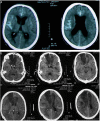Therapeutic approaches to cerebral vasospasm complicating ruptured aneurysm
- PMID: 21577350
- PMCID: PMC3093235
- DOI: 10.4081/ni.2009.e13
Therapeutic approaches to cerebral vasospasm complicating ruptured aneurysm
Abstract
Cerebral vasospasm is a serious complication of ruptured aneurysm. In order to avoid short- and long-term effects of cerebral vasospasm, and as there is no single or optimal treatment modality employed, we have instituted a protocol for the prevention and treatment of vasospasm in patients suffering aneurysmal sub-arachnoid hemorrhage (SAH). We then reviewed the effectiveness of this protocol in reducing the mortality and morbidity rate in our institution. In this study we present a retrospective analysis of 52 cases. Between March 2004 and December 2008 52 patients were admitted to our service with aneurysmal SAH. All patients commenced nimodipine, magnesium sulphate (MgSO(4)) and triple H therapy. Patients with significant reduction in conscious level were intubated, ventilated and sedated. Intracranial pressure (ICP) monitoring was used for intubated patients. Sodium thiopental coma was induced for patients with refractory high ICP; angiography was performed for diagnosis and treatment. Balloon angioplasty was performed if considered necessary. Using this protocol, only 13 patients (25%) developed clinical vasospasm. Ten of them were given barbiturates to induce coma. Three patients underwent transluminal balloon angioplasty. Four out of 52 patients (7.7%) died from severe vasospasm, 3 patients (5.8%) became severely disabled, and 39 patients (75%) were discharged in a condition considered as either normal or near to their pre-hemorrhage status. Our results confirm that the aforementioned protocol for treatment of cerebral vasospasm is effective and can be used safely.
Keywords: cerebral vasospam; ruptured aneurysm..
Figures



Similar articles
-
Coadjuvant Treatment of Vasospasm in Ruptured Unsecured Cerebral Aneurysms with Aggressive Angioplasty, Intra-Arterial Nimodipine, and Aneurysm Embolization.World Neurosurg. 2018 Aug;116:e452-e459. doi: 10.1016/j.wneu.2018.05.005. Epub 2018 May 16. World Neurosurg. 2018. PMID: 29753899 Review.
-
Early strategy of scepter XC balloon angioplasty and simultaneous Nimodipine infusion for vasospasm following ruptured aneurysm.BMC Neurol. 2020 Jul 7;20(1):271. doi: 10.1186/s12883-020-01856-4. BMC Neurol. 2020. PMID: 32635892 Free PMC article.
-
Reversal of severe cerebral vasospasm in three patients after aneurysmal subarachnoid hemorrhage: initial observations regarding the use of intraventricular sodium nitroprusside in humans.Neurosurgery. 1999 Jan;44(1):48-57; discussion 57-8. doi: 10.1097/00006123-199901000-00026. Neurosurgery. 1999. PMID: 9894963 Clinical Trial.
-
Impact of percutaneous transluminal angioplasty for treatment of cerebral vasospasm on subarachnoid hemorrhage patient outcomes.Neurocrit Care. 2011 Aug;15(1):28-33. doi: 10.1007/s12028-010-9499-y. Neurocrit Care. 2011. PMID: 21360234
-
Current management and treatment of cerebral vasospasm complicating SAH.CNS Neurol Disord Drug Targets. 2013 Mar;12(2):233-41. doi: 10.2174/1871527311312020010. CNS Neurol Disord Drug Targets. 2013. PMID: 23394535 Review.
Cited by
-
The Use of Standardized Management Protocols for Critically Ill Patients with Non-traumatic Subarachnoid Hemorrhage: A Systematic Review.Neurocrit Care. 2020 Jun;32(3):858-874. doi: 10.1007/s12028-019-00867-5. Neurocrit Care. 2020. PMID: 31659678
-
Intravenous magnesium infusion for the prevention of symptomatic cerebral vasospasm after aneurysmal subarachnoid hemorrhage.J Korean Neurosurg Soc. 2012 Aug;52(2):75-9. doi: 10.3340/jkns.2012.52.2.75. Epub 2012 Aug 31. J Korean Neurosurg Soc. 2012. PMID: 23091662 Free PMC article.
References
-
- Oertel M, Boscardin WJ, Obrist WD, et al. Post traumatic vasospasm: the epidermiology, severity, and time course of underestimated phenomenon: a prospective study performed in 299 patients. J Neurosurg. 2005;103:812–24. - PubMed
-
- Findlay JM, Macdonald RL, Weir BKA. Current concepts of pathophysiology and management of cerebral vasospasm following aneurysmal subarachnoid hemorrhage. Cerebrovasc Brain Metab Rev. 1991;3:336–61. - PubMed
-
- Oshiro EM, Walter KA, Piantadosi S, et al. A new subarachnoid grading system based on the Glasgow Coma Scale: A comparison with Hunt and Hess World Federation of Neurosurgical Surgeons Scales in a clinical series. Neurosurgery. 1997;41:140–7. - PubMed
-
- Fisher CM, Kistler JP, Davis JM. Relation of cerebral vasospasm to subarachnoid haemorrhage visualized by computed tomographic scanning. Neurosurgery. 1980;6:1–9. - PubMed
-
- Macdonald RL, Rosengart A, Huo D, Karrison T. Factors associated with the development of vasospasm after planned surgical treatment of aneurysmal subarachnoid hemorrhage. J Neurosurg. 2003;99:644–52. - PubMed
LinkOut - more resources
Full Text Sources

